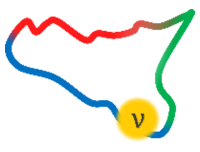Speaker
Description
Next-generation experiments for neutrinoless double beta decay search (0νββ) employing the bolometric technique plan to exploit the characteristic scintillation yields of particles to achieve particle discrimination, thus reducing their background.
In a bolometer, when a particle interacts within the main absorber, energy is deposited as phonons (i.e. crystal excitations). By measuring their effect with a sensor, the energy can be reconstructed, heat channel. Additionally, if the absorber is also a scintillating crystal, part of the energy escapes as scintillation photons, light channel. The energy ratio deposited along the two channels is characteristic of the interacting particle. Thus, by collecting the emitted photons with an additional absorber, like a germanium wafer, it is possible to evaluate the ratio to then infer about the interacting particle’s nature.
The expected response of a bolometric detector can be obtained by means of an ohmic heater directly glued on the phonon absorber and used to inject a known amount of energy. However, this approach does not provide information about how light is collected and then transduced into a signal, effects that influence the pulse shape. An alternative and more interesting approach involves the emission of light pulses from a laser source directly to the absorbers. However, this opens two fundamental problems: system which the light travels through and the feasibility of an energy calibration relying only on the expected photo-statistics.
The work described in my poster is developed in the framework of the CUPID experiment, where Li$_2$ $^{100}$MoO$_4$ scintillating crystals will face Germanium wafers acting as light absorbers. Both of them will be equipped with Ge-Neutron Transmutation Doped (NTD) thermistors, used for both the heat and light channels. I will elaborate on the current status of the light injection system and on feasibility studies for the photo-statistics performed with a PMT-based system as a substitute for the actual light detector, for which several cross-checks become possible that otherwise would not be accessible.

